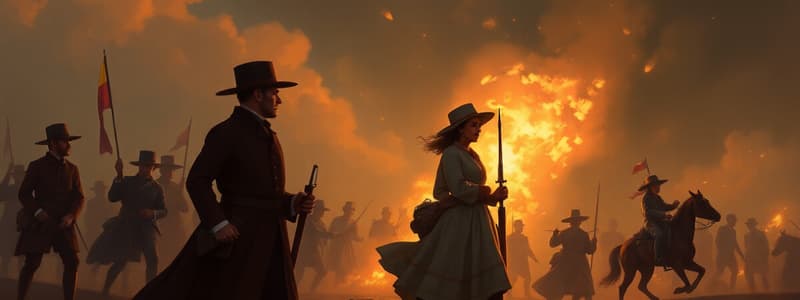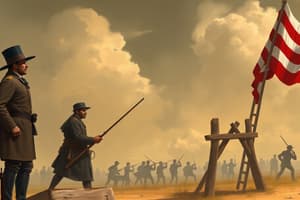Podcast
Questions and Answers
What principle did the Kansas-Nebraska Act use to determine the status of slavery in the territories?
What principle did the Kansas-Nebraska Act use to determine the status of slavery in the territories?
- Popular sovereignty (correct)
- State rights
- Judicial decision
- Federal mandate
What was one of the major consequences of the Kansas-Nebraska Act?
What was one of the major consequences of the Kansas-Nebraska Act?
- The establishment of the Underground Railroad
- The immediate abolition of slavery in Kansas
- Increased tensions between pro-slavery and anti-slavery factions (correct)
- The strengthening of the Missouri Compromise
Based on prior legal decisions regarding slavery, what prediction can be made about the ruling in Dred Scott's case?
Based on prior legal decisions regarding slavery, what prediction can be made about the ruling in Dred Scott's case?
- The Court will rule in favor of slaveholders. (correct)
- The Court will reject the concept of popular sovereignty.
- The Court will focus on the location of his residence.
- The Court will rule in favor of Dred Scott.
What impact did the Missouri Compromise have on the Dred Scott case?
What impact did the Missouri Compromise have on the Dred Scott case?
What strategy did Frederick Douglass use to advocate for the abolition of slavery?
What strategy did Frederick Douglass use to advocate for the abolition of slavery?
What was a significant effect of the Fugitive Slave Act on Northern citizens?
What was a significant effect of the Fugitive Slave Act on Northern citizens?
Which of the following was NOT a provision of the Missouri Compromise?
Which of the following was NOT a provision of the Missouri Compromise?
How did Henry Clay contribute to the balance between free and slave states?
How did Henry Clay contribute to the balance between free and slave states?
What legislative action did the Compromise of 1850 allow for territories like Utah and New Mexico?
What legislative action did the Compromise of 1850 allow for territories like Utah and New Mexico?
What was a consequence of the Fugitive Slave Law on the Underground Railroad?
What was a consequence of the Fugitive Slave Law on the Underground Railroad?
What was a significant impact of 'Uncle Tom's Cabin' on the abolitionist movement?
What was a significant impact of 'Uncle Tom's Cabin' on the abolitionist movement?
How did Harriet Beecher Stowe strengthen her argument against slavery?
How did Harriet Beecher Stowe strengthen her argument against slavery?
What motivated John Brown's actions in the abolitionist movement?
What motivated John Brown's actions in the abolitionist movement?
What was the outcome of John Brown's raid at Harpers Ferry?
What was the outcome of John Brown's raid at Harpers Ferry?
What primary reason did Southern states give for their secession?
What primary reason did Southern states give for their secession?
Flashcards
Fugitive Slave Act
Fugitive Slave Act
The Compromise of 1850, proposed by Henry Clay, included this law that required free states to return escaped slaves to their owners, even if they were in free states. This fueled tensions between the North and South, contributing to the Civil War.
Missouri Compromise
Missouri Compromise
This agreement, made in 1820, admitted Missouri as a slave state and Maine as a free state, maintaining the balance between free and slave states. It also prohibited slavery in the Louisiana Purchase territory north of the 36°30′ parallel, except for Missouri.
Popular Sovereignty
Popular Sovereignty
This concept allowed people living in a region to vote on whether or not to allow slavery. Utah and New Mexico were included in this provision of the Compromise of 1850.
Henry Clay
Henry Clay
Signup and view all the flashcards
John C. Calhoun
John C. Calhoun
Signup and view all the flashcards
What did the Kansas-Nebraska Act decide?
What did the Kansas-Nebraska Act decide?
Signup and view all the flashcards
What is popular sovereignty?
What is popular sovereignty?
Signup and view all the flashcards
What was the effect of the Kansas-Nebraska Act?
What was the effect of the Kansas-Nebraska Act?
Signup and view all the flashcards
How did abolitionists convince Americans to end slavery?
How did abolitionists convince Americans to end slavery?
Signup and view all the flashcards
How was Frederick Douglass a key figure in the abolitionist movement?
How was Frederick Douglass a key figure in the abolitionist movement?
Signup and view all the flashcards
What is "Uncle Tom's Cabin"?
What is "Uncle Tom's Cabin"?
Signup and view all the flashcards
Who was John Brown?
Who was John Brown?
Signup and view all the flashcards
Why did the Southern states secede?
Why did the Southern states secede?
Signup and view all the flashcards
What made Harriet Beecher Stowe's argument against slavery so powerful?
What made Harriet Beecher Stowe's argument against slavery so powerful?
Signup and view all the flashcards
What was "Bleeding Kansas"?
What was "Bleeding Kansas"?
Signup and view all the flashcards
Study Notes
Compromise of 1850
- Allowed California to enter the Union as a free state
- Included the Fugitive Slave Act, requiring the return of escaped slaves
- Temporarily eased tensions but contributed to the Civil War debate
Southern and Northern States
- Southern states were slave states (Confederate)
- Northern states were free states (Union)
- Utah and New Mexico allowed slavery through popular sovereignty (voter decision)
Fugitive Slave Law
-
Increased tensions between North and South
-
Required citizens in free states to assist in capturing escaped slaves
-
Favored slave owners
-
Led to increased activity on the Underground Railroad
-
Disturbed Northerners and abolitionists by forcing them to aid in the return of escaped slaves
-
Court officials' compensation varied based on the judge's decision ($10 vs $5)
-
Fined those who hindered the arrest of fugitive slaves (over $1,000 and 6 month jail time)
Missouri Compromise
- Balanced slave and free states (Missouri as slave, Maine as free)
- Prohibited slavery in Louisiana Purchase territory north of the 36°30' parallel (except Missouri)
- Increased tensions which made conflicts more likely
- Conflicts in views divided both sides
Kansas-Nebraska Act
- Allowed Kansas and Nebraska territories to decide on slavery (popular sovereignty)
- Strengthened democratic principles by allowing settlers to vote
- Caused violent conflicts (Bleeding Kansas)
- Intensified the debate over slavery
Dred Scott
- Supreme Court decision that likely ruled against Dred Scott's freedom
- Based on past legal handling of slavery, the court will likely rule that Dred Scott remains a slave, as they had traditionally protected slaveholders rights
Abolition Movement
- Frederick Douglass was a powerful speaker and writer who fought for abolition
- Published autobiographies and an abolitionist newspaper (The North Star)
- Collaborated with other abolitionists and met political leaders
- Abolitionists were disliked by Northerners because they increased tensions with the South
John Brown at Harper's Ferry
- John Brown opposed slavery
- Led a retaliatory raid, killing five people in Lawrence, Kansas
- Attempted a rebellion at Harper's Ferry
- Expected uprising did not occur, he was captured and executed, becoming a martyr for the abolitionist cause
1864 Election
- Showcased the strength and resilience of the U.S.'s democratic system
- Held during the Civil War
- Candidates were Abraham Lincoln and George McClellan
Emancipation Proclamation
- Issued in 1863 by President Abraham Lincoln
- Freed slaves in Confederate territories
- Civil War shifted into a fight against slavery
Gettysburg Address
- Lincoln's speech in 1863 emphasizing equality, national unity, and sacrifices for freedom
- Reminded Americans of founding ideals and inspired them to fight for a united nation
- Emphasized the sacrifices of soldiers and the importance of freedom for all
Union Generals: Sherman and Grant
- Grant was known for calm, decisive leadership
- Sherman was known for bold and innovative tactics
Civil War End
- The Civil War ended in 1865
- The U.S faced racial tensions, a destroyed Southern economy and the need to unify the nation
13th Amendment
- Removed slavery in 1865
- Removed the issue of slavery
Problems Solved/Caused by the Civil War
- Solved: Abolishment of slavery, preservation of the Union, strengthened federal government and civil rights
- Caused: Racial inequality and discrimination, economic and social divisions between North & South, continued political/social tensions, the legacy of slavery
Studying That Suits You
Use AI to generate personalized quizzes and flashcards to suit your learning preferences.




